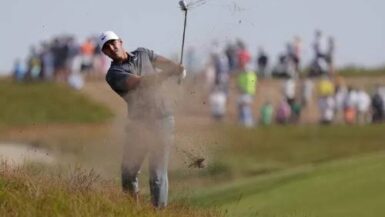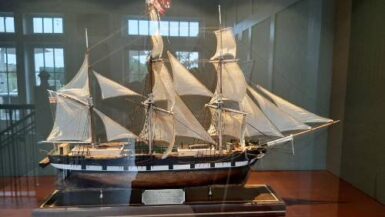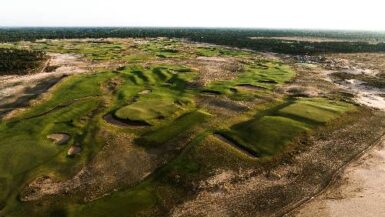OAKMONT, PA – They’re called “half-par holes” be cause they play either much easier or much harder than the par on the scorecard states, and they are often the key to winning a golf tournament. Be it stroke play or match play, the ability to negotiate the razor thin edge between a birdie (or even eagle) or a triple bogey is the difference between having your name engraved on the trophy or being a cautionary tale.
That’s one of the biggest reasons why the USGA keeps coming back to Oakmont for the U.S. Open since 1927. So many of the holes straddle that fine line – keeping golfers’ nerves frayed, and fans mesmerized – the drama is so incomparable that the stories echo through the centuries. Let’s take a closer look at some of the holes that will decide the 116th National Championship and some of the terror they’ve doled out.
1 – Par-4, 482 Yards

From the moment Ron Read’s replacement as U.S. Open 1st tee starter calls your name and says “Play Away,” it’s Game On. Straight as a pool cue, the fairway tumbles downhill. A string of five bunkers flank the landing area on the left, while out of bounds guards the right. Moreover, the green slopes severely away from the player.
“It’s a one bounce and on hole,” explained 2013 U.S. Open Champion Justin Rose. “It makes strategy so much more important…missing on the correct side of the hole.”
You can’t win the golf tournament on the first hole, but at Oakmont you sure can lose it. Gary Player, winner of nine major championships, is a good example. He opened the 1978 PGA Championship with a godawful 76…which was triggered by four-putting the first green.
“I had a lot of confidence before I teed off,” he told the assembled media. “I lost it on the first tee.”
Of course it could be worse – this is Oakmont after all. Take what happened to a college golfer in the 1937 national collegiate tournament, for example. He let his opponent win the title on the first tee without ever hitting a golf ball. In a playoff for the title, he sliced one into the trees on the right towards the out of bounds. He hit four more in the same place, conceded the match in disgust, and walked in.
Caddies later found his first ball in bounds.
2 – Par-4, 340 yards
Tournament set-up maven Mike Davis’s experiment with floating tee boxes and graded rough has added an excitement and mystery to the U.S. Open that was missing during the “harder is better” era espoused by Tom Meeks and his predecessors. Though this hole will actually play three yards shorter than it did in 1983, the temptation to haul out driver or 3-wood on the hole that surrendered more birdies than any other in 2007 may trigger a costly mistake. With one bunker almost smack-dab in the middle of the fairway and a drainage ditch providing a hard edge on the right, those that don’t make birdie here might feel as though they lost at least one shot to the field.
8 – Par-3, 288 yards
“Nice going!” Paul Goydos shouted mockingly at Mike Davis back in 2007. “In my two decades of playing on tour we have never had a hole where you could have a long drive contest and closest to the hole in the same hole.” The idea was to hearken back to the Golden Age and the days when one par-3 required either a driver or a 3-wood, but when a par-3 plays longer than a par-4 on the same course for the same championship, is it perhaps time for a different idea? After all, this hole was the fifth hardest on he course in 2007 and only 27% of the players hit the green in regulation.
10 – Par-4, 462 yards
“The openers on both nines play very similar, you have to hit the fairway off the tee, and then basically there’s a little bit of luck involved with getting the right bounce off of the front edge of the green,” said Rose, again echoing his comments about the first hole.
Ten has also been a graveyard of sorts over the years. It played the second hardest hole on the course in 2007, but perhaps the most famous scalp it collected was that off two-time U.S. Open champion Cary Middlecoff.
It happened 63 years ago, so if memories are hazy and stories contradict each other, cut them some slack, but sources disagree over whether it was a tractor trailer or a flatbed that sailed down the Pennsylvania Turnpike with Middlecoff’s golf ball, but that was the last we saw that week of either the Good Doctor or the ball at the 1953 U.S. Open. After opening with rounds of 76 and 73, then percolating further down the nether-reaches of the leaderboard with a front nine 38 Middlecoff went from bunker to bunker on 10. Either way, the Good Doctor, who wasn’t known for his phlegmatic demeanor on the golf course – oops! – opened his shoulders a bit too much with the hooded wedge and sent the ball into the Pennsylvania Turnpike, where it landed on the back of a truck and journeyed off into both the sunset and golf history.
15 – Par-4, 500 yards
A blind tee shot, more Church Pews, a fairway tilted sharply left to right, gargantuan length, and a green set obliquely from the fairway equal a hole that played the second hardest on the inward nine in 2007, a bloated .40 strokes harder than its listed par.
“I might hit 2-iron off there…because if I miss it left on the Church Pews, I’m going to have to lay up,” noted PGA Champion and pre-tournament favorite Jason Day. “I think you can lay back here on this golf course,” he noted interestingly. “You can’t try and overpower it…..You’d rather hit a 7-iron out of the fairway than a wedge out of the rough.”
17 – Par-4, 313 yards.
Proving that length is not what you need to make a hole difficult, this pint sized Titanic has sunk several famous names including, most recently, Jim Furyk. Anything from a 2 to an 8 is possible.
In 1973 the members shelled out close to $68,000, (inflation adjusted for 1973), to make the hole longer and tougher, adding a new tee box and trees by the green. It measured 322 yards and seemed safely out of reach…until the first round when Jack Nicklaus drove the green and made the putt for eagle.
“Oh, Hell!” moaned one shell-shocked member. “We spent all that money and Nicklaus drove it the first day!” Nicklaus even got some bragging rights over playing partner Bob Goalby. According to reports, when Goalby saw the Golden Bear pull out driver, he turned to a marshal and said, “Well if tha isn’t a stupid shot.” After Nicklaus hit, he said the same thing to Jack. Nicklaus laughed and then said, “it’s on the green.”
How does the song go? Don’t tug on Superman’s cape.
That gnarled little grinning garden gnome of a hole also saved Jack’s bacon in 1962, the year Nicklaus broke through for his first major, winning in a playoff over Arnold Palmer. In fact, he may owe his career to that hole or at least to a droopy little tree that looked like something out of “A Charlie Brown Christmas.”
Phil Rodgers came to the 17th on the first day of the tournament looking for a jump start to his tournament. He tried to drive the green, but his ball got lodged in the tree branches. So he tried to play it….and took three shots just to dislodge it and four more to hole out for a whopping eight on what then was a mere 292 yards.
Smooth move, Ex-lax.
The quadruple bogey cost him much more than four shots to par. He missed out on the playoff with Nicklaus and Palmer by two shots. A drop from the unplayable lie and a simple pitch to the green might have gone a long way come Sunday afternoon.
Pound for pound is Oakmont the greatest major championship golf course in the World? The hardest? The most cerebral? Certainly it’s on the short list. Brains and brawn, beauty and difficulty, history and agony, they are all cheek and jowl at Henry Fownes’s great grassy guillotine. But therein lies the fine line, between he false and true, the lightning bug and the lightning, the Cup and the lip, immortality and a lifetime of regret. For a champion, it’s the only way to live.







